
Search
The Renewable Energy site for Do-It-Yourselfers
Window Shading for
Cooling
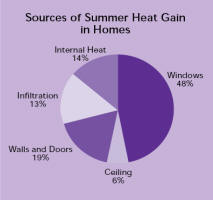
Shading
windows in the summer to prevent excessive solar gain can greatly reduce
overheating of your house and cut AC bills, or eliminate the need for AC in some
climates. A hundred square feet of east facing window can gain over one
hundred thousand BTU on a sunny summer day! This is like running your furnace
for a couple hours, and is sure to result in overheating, high AC bills, and
high greenhouse gas emissions. The pie
chart from the Arizona Public Service Company
shows that typically, windows
account for about half of the total house heat gain.
|
|
South facing windows can be shaded
with overhangs that will block the high summer sun, but allow
the low winter sun to shine in and provide passive solar heating when its
wanted. Overhangs do not work for east or west facing windows, since
the sun is low in the sky when shining on the east and faces of the house.
External shading devices work best for east and west exposures -- these include
trees, trellis, external shades, -- anything that blocks the sun. Inside
shading devices are not as effective as external shading, but can still be
helpful. Internal shades that are reflective on the outside surface will
be the most effective as they reflect some of the sun right back out the window.
Details below.
For some areas that have hot days but
somewhat cooler nights, a combination of reducing heat gain during the day,
coupled with
ventilation at night can reduce or even eliminate the need for AC. Shading can be a big
part of reducing the daytime heat gains. Other techniques for reducing daytime heat gains are covered on the
Cooling and
Conservation pages.
Techniques for providing effective night ventilation (e.g. whole house fans)
are provided by the Cooling page. In
addition, making the house outer surfaces reflective reduces heat gain.
The sections below give my 2 cents
worth on window shading.
If you know of, or have experience
with shading techniques that should be added please let me know. If you
have have some pictures of shading devices you have installed that you
think would be helpful to others, please send them in --
Gary.
Overhangs
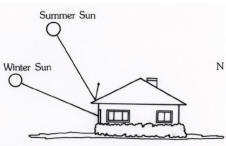 A
well designed overhang can shade south facing windows from the high summer sun,
while still allowing the low winter sun to shine in and provide welcome solar
heating. Overhangs are not effective on east or west facing windows
because the sun is too low in the morning and afternoon for an overhang to
provide any effective shade -- use the other techniques discussed below for east
and west facing windows. The sketch shows how overhangs take
advantage of the fact that the sun is high in the summer and low in the winter.
A
well designed overhang can shade south facing windows from the high summer sun,
while still allowing the low winter sun to shine in and provide welcome solar
heating. Overhangs are not effective on east or west facing windows
because the sun is too low in the morning and afternoon for an overhang to
provide any effective shade -- use the other techniques discussed below for east
and west facing windows. The sketch shows how overhangs take
advantage of the fact that the sun is high in the summer and low in the winter.
The overhang for south facing windows
can be incorporated in the roof overhang, or can be a separate overhang or
awning just over the window areas.
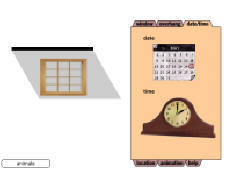
Look here for two easy to use tools
that will allow you to design optimal window (or even house) shading structures:
http://www.builditsolar.com/References/SunChartRS.htm#Overhangs
Update:
It should be noted that overhangs on south facing windows are only effective
in blocking direct sun.
In looking at the solar radiation
numbers for a few locations, it appears that only
about half of the radiation
arriving at a window is direct solar radiation. The rest of
the radiation is diffuse sky
radiation and reflected radiation from the ground.
So, while overhangs are quite
helpful, they will still let though about 50%
of the solar radiation.
This means that a strategy that uses sun blocking solar screens
or trellis or landscaping (see
below) may be more effective than an overhang.
Or, a combination of the two
could be used.
Of course, for east and west
facing windows, where overhangs are not effective, some form
of external screen, trellis, or
landscaping will be the only effective solution.
You can get the average values of
diffuse and total solar radiation on south, north, east, and west facing
windows in your location from the
"Solar Radiation Data Manual for Buildings" at this NREL site:
http://www.nrel.gov/rredc/publications.html
My thanks to Richard Crume for
pointing this out.

Shading overhangs
The Trellis
An exterior vertical trellis works
well for shading East or West facing windows, and preventing excessive solar
gain. These windows cannot be shaded by overhangs because the sun is low
in the sky when shining on the East and West sides of the house.
Plants growing on the trellis can
provide some additional shading in the summer and allow more sun during the
winter when its desirable. A larger trellis can cool an entire wall plus
windows and further reduce heat gain.
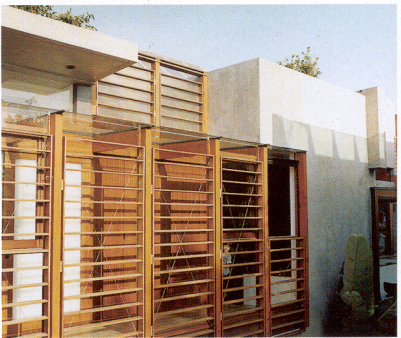
A wood trellis design that does not
look so effective for low sun -- maybe with plants it would work better?
Or, angled vanes.
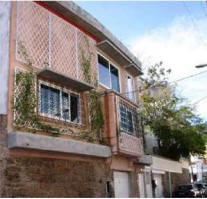
An aluminum trellis on the eco house
that is populated with plants during the summer.
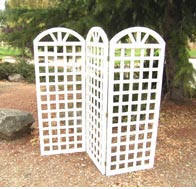
A moveable sun screen that
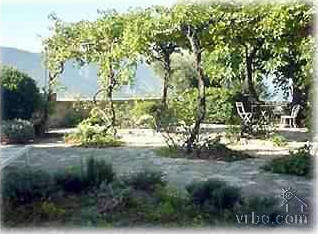
could be positioned for
summer sun protection outside
east or west windows.
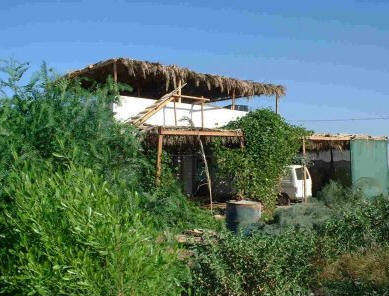
Nice trellis and
tree arrangement
for outside
shading.
The gone native
look.
Looks nice and cool.
Horizontal trellis
to shade deck and windows
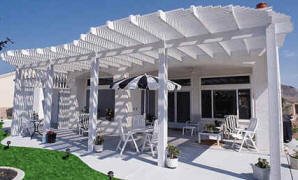
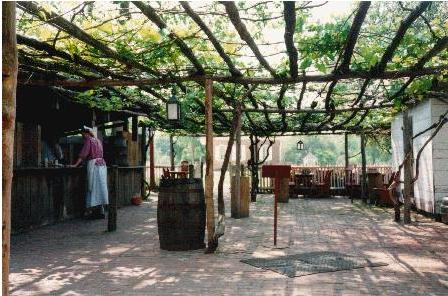
Grapevine shading on a Trellis -- colonial Williamsburg.
Plans for a DIY Trellis:
| Elegant Shade Structure Popular
Mechanics
www.popularmechanics.com
|
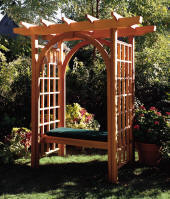 Plans
for a very elegant shade structure. This could be used as a standalone
shade structure or adapted to shade a house window. Plans
for a very elegant shade structure. This could be used as a standalone
shade structure or adapted to shade a house window.Very detailed plans. |
| Windsor Shade shelter California
Redwood Association
www.calredwood.org/ref/pdf/shelter.pdf
|
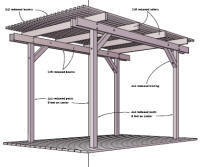 Detailed
plans for a free standing shading structure. Detailed
plans for a free standing shading structure.Could be used for yard/deck
shade, or to shade a window. |
Some links with external shading
devices:
http://www.thenaturalhome.com/shadecloth.htm
Note how the tilted glass shown in
some of these examples is particularly difficult to shade. It also has
much higher solar gains in the summer than vertical glass.
http://www.eere.energy.gov/consumer/your_home/landscaping/index.cfm/mytopic=11940
Some landscaping/shading advice
from the eere site.
http://www.calredwood.org/ref/releases/trellis/rel_trellis.htm
Some deck shading Trellis designs
from the California Redwood Association
Trees
Trees work well to provide shading
for windows on all exposures. In most climates, the leaves fall off in the
winter to provide welcome sunshine and solar gain.
Large trees can also shade full walls, which can reduce the outside wall
temperature from in the 140F range in full sunshine down to something more like
the air temperature -- the heat transmission through the wall, which depends on
the difference between the inside and outside wall temperatures is
correspondingly reduced. Reflective walls can also help.
Evergreen trees can also provide wind
protection from cold winter winds.
Here is an excerpt from the North
Carolina Solar Center: Passive Cooling for you NC Home
Landscaping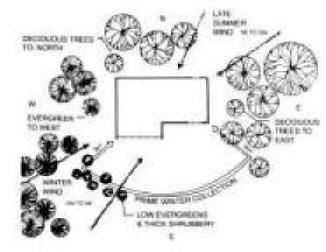
Landscaping is an effective and pleasant means of providing shading for your
house. An effectively planned landscape will block out the hot summer sun,
encourage warming sun to enter the house in winter, deflect the cold winter
winds, and channel breezes for cooling in summer.
In general, an ideal landscape plan for North Carolina would include trees to
the east and west of the house to provide summer shading, with the area to the
south of the house left relatively clear in order to allow solar heating in
winter. Trees will be most effective if they shade east and west windows,
where the most heat can enter, but shading east and west walls and the roof is
also important. Even trees which do not directly shade the house, such as
those planted to its north, are valuable because they reduce the
temperature of the air surrounding the house. Figure 1 shows an "ideal" site
plan for most of North Carolina.
These two guides provide some
additional information on using landscaping for shading and cooling in southern
climate:
Passive Cooling for Your NC Home
-- NC Solar Center
Landscaping for
Energy Efficiency -- South Carolina Energy Office Energy Brief
External Shades
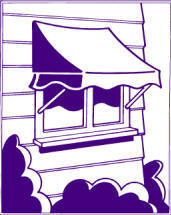
External rollup shades made from a shade
cloth material (as is used in greenhouses) can block a high percentage of the
sunlight while still allowing some useful daylight to enter the room. Such
shade cloth can be ordered in various grades that block different amounts of
sunlight. Greenhouse supply places and some home centers carry a wide
variety of shade cloth. Awnings (either fixed or moveable) are also
effective for blocking unwanted sun. Awnings to block the sun on east or
west facing windows are more difficult to design, since the sun is low when it
shines on east or west walls -- moveable awnings may be preferred for windows on
east and west walls.
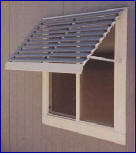
Awning with slats.
Plans for simple shades you can make
for rollup shade cloth exterior blinds:
Rollup Shades made from shade cloth:
Awning plans:
Sun "Screens"
| Sun Screens
http://sunbloxinc.com/
An article on this product:
www.energyrefuge.com/archives/solar_screens.htm
The screen material from Phifer:
http://www.phifer.com/sunprod.htm
And another -- there are lots of
them:
http://www.ezsnapdirect.com/
Exterior window shades -- search for shades:
A similar screening from
Real goods |
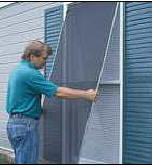 This
seems like a pretty good idea for reducing summer heat gain on windows.
The shades block up to 90% of sunlight, and mount in vinyl frames (like bug
screens). It looks like they would work on a wide variety of windows,
including ones that would be difficult to handle with other shading
techniques. They do the shading on the outside, where its most effect. This
seems like a pretty good idea for reducing summer heat gain on windows.
The shades block up to 90% of sunlight, and mount in vinyl frames (like bug
screens). It looks like they would work on a wide variety of windows,
including ones that would be difficult to handle with other shading
techniques. They do the shading on the outside, where its most effect.
It seems like a DIY version could be worked out. The Phifer SunTex
material is said to be available at some home centers. Frames could
probably be made from the same material that home centers sell for making
insect screens. |
Rollup Shades
| Rollup shade plans
From Charlie's Green House
The Plans (pdf)
|
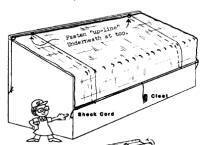 Plans
for a simple rollup shade from Charlie's Greenhouse in Seattle. Plans
for a simple rollup shade from Charlie's Greenhouse in Seattle. |
Local awning makers and shops that do
canvas work can also be quite competitive in some areas.
Some links to commercial suppliers: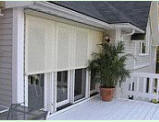
There are many, many commercial
suppliers of exterior shades and awnings
www.backyardcity.com/window/shades/SunSetter-Window-Shades.htm
Rollup exterior shade cloth shades.
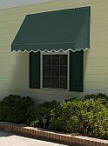
Retractable awning.
Inside Shades
Inside shades are the least effective
way to block unwanted solar gain through windows, since the sun has already
penetrated the window before it gets to the shade, but they can still be
effective. To be most effective the face of the blind that faces out
should be as reflective as possible to reflect as much sunlight as possible back
out the window. Blinds that fit fairly tightly and minimize air
circulation behind blind are also more effective.
Some links:
http://www.interiordesignexpressions.com/products-wt.htm
One supplier of inside shades (one
of many, many)
Reflective Window Films
Reflective window films can be
applied to inside of the inside pane of glass. These films reflect and/or
absorb some of the solar energy, resulting in less heat gain to the house.
Here is one supplier of DIY window
film:
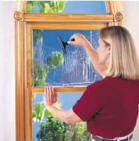
Gila Window Film:
www.gilafilms.com/Residential/residential-window-film.htm
It appears from the "performance"
data that some of the films may absorb/reflect up about half of the solar
heat.
Installation Instructions:
www.gilafilms.com/Residential/Residential-film-application.htm
A negative effect of window films is
that they reduce solar heating gain in the winter.
Windows
Windows can be designed to absorb a
high fraction of solar energy, and this helps to reduce solar heat gain.
The SHGC (Solar Heat Gain Coefficient) is the fraction of solar heat transmitted through the window. For new windows, the Solar Heat Gain Coefficient (SHGC) will
be marked on the window. For climates where heating bills are low
and cooling bills are high, windows with low SHGC's are preferred to cut down
on summer solar heat gain. The low SHGC does have the negative effect of
reducing winter time passive solar heating. If you are in the market
for for
new windows, the website
www.EfficientWindows.org has excellent material on selecting the best
windows for various parts of the country and different window situations.
It provides detailed information on zillions of different windows by jillions
manufacturers.
From the Greenhouse World
Greenhouses require shading, and many
products and techniques have evolved to provide shading. It may be worth a
taking a look at some of these to see if they can be adapted to your house.
The greenhouse solutions tend to be simpler and cheaper (e.g. shading "paint"
applied directly to the glass -- it washes off for the winter).
Gary 4/23/06, May 18, 2008


 A
well designed overhang can shade south facing windows from the high summer sun,
while still allowing the low winter sun to shine in and provide welcome solar
heating. Overhangs are not effective on east or west facing windows
because the sun is too low in the morning and afternoon for an overhang to
provide any effective shade -- use the other techniques discussed below for east
and west facing windows. The sketch shows how overhangs take
advantage of the fact that the sun is high in the summer and low in the winter.
A
well designed overhang can shade south facing windows from the high summer sun,
while still allowing the low winter sun to shine in and provide welcome solar
heating. Overhangs are not effective on east or west facing windows
because the sun is too low in the morning and afternoon for an overhang to
provide any effective shade -- use the other techniques discussed below for east
and west facing windows. The sketch shows how overhangs take
advantage of the fact that the sun is high in the summer and low in the winter.








 Plans
for a very elegant shade structure. This could be used as a standalone
shade structure or adapted to shade a house window.
Plans
for a very elegant shade structure. This could be used as a standalone
shade structure or adapted to shade a house window.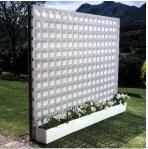 Plans
for a simple wood framed, shade cloth trellis fro Alnet
Plans
for a simple wood framed, shade cloth trellis fro Alnet Detailed
plans for a free standing shading structure.
Detailed
plans for a free standing shading structure.


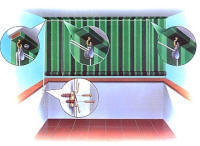 Plans
for a simple rollup shade from shade cloth.
Plans
for a simple rollup shade from shade cloth.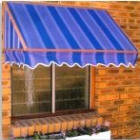 Plans
for a simple wood framed, shade cloth awning to provide window shade and
reduce heat gain.
Plans
for a simple wood framed, shade cloth awning to provide window shade and
reduce heat gain.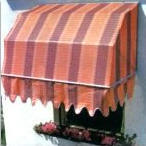 Retractable
version
Retractable
version This
seems like a pretty good idea for reducing summer heat gain on windows.
The shades block up to 90% of sunlight, and mount in vinyl frames (like bug
screens). It looks like they would work on a wide variety of windows,
including ones that would be difficult to handle with other shading
techniques. They do the shading on the outside, where its most effect.
This
seems like a pretty good idea for reducing summer heat gain on windows.
The shades block up to 90% of sunlight, and mount in vinyl frames (like bug
screens). It looks like they would work on a wide variety of windows,
including ones that would be difficult to handle with other shading
techniques. They do the shading on the outside, where its most effect.
 Plans
for a simple rollup shade from Charlie's Greenhouse in Seattle.
Plans
for a simple rollup shade from Charlie's Greenhouse in Seattle.

